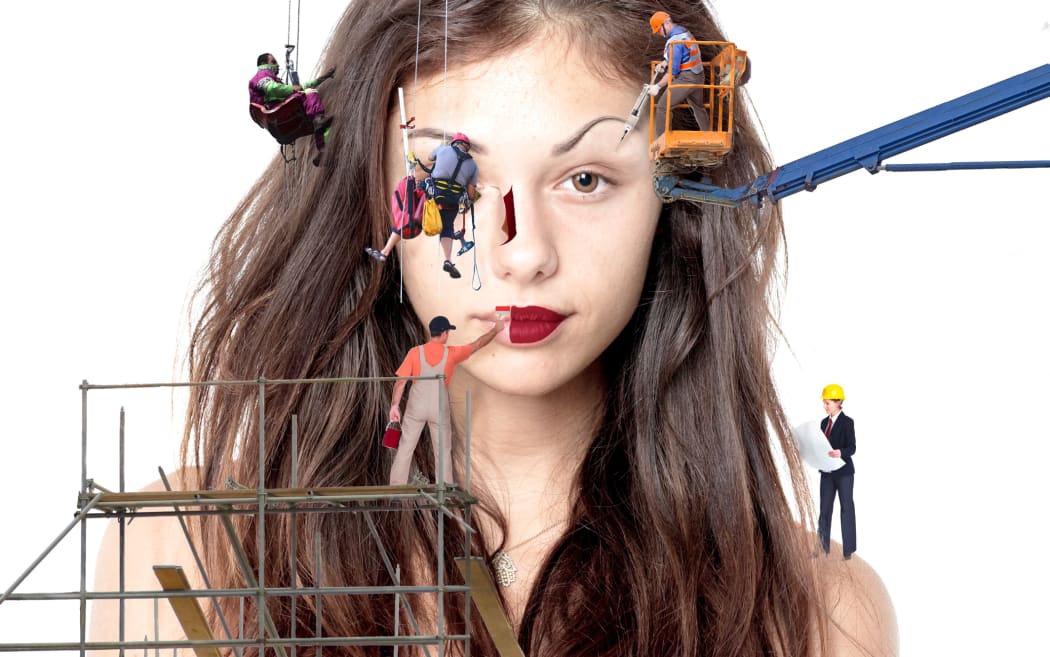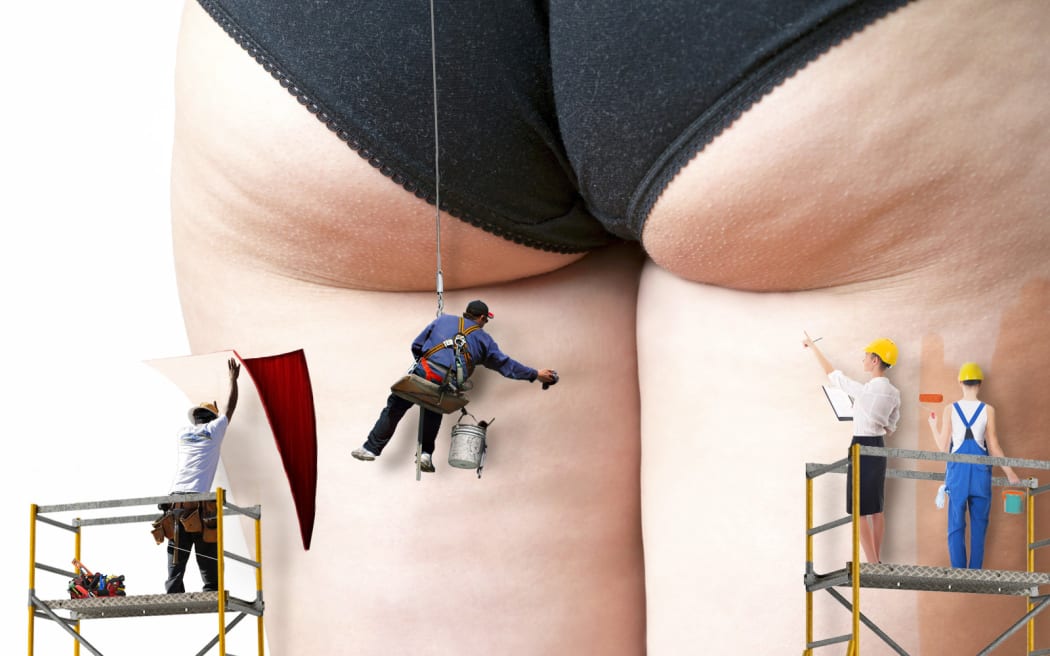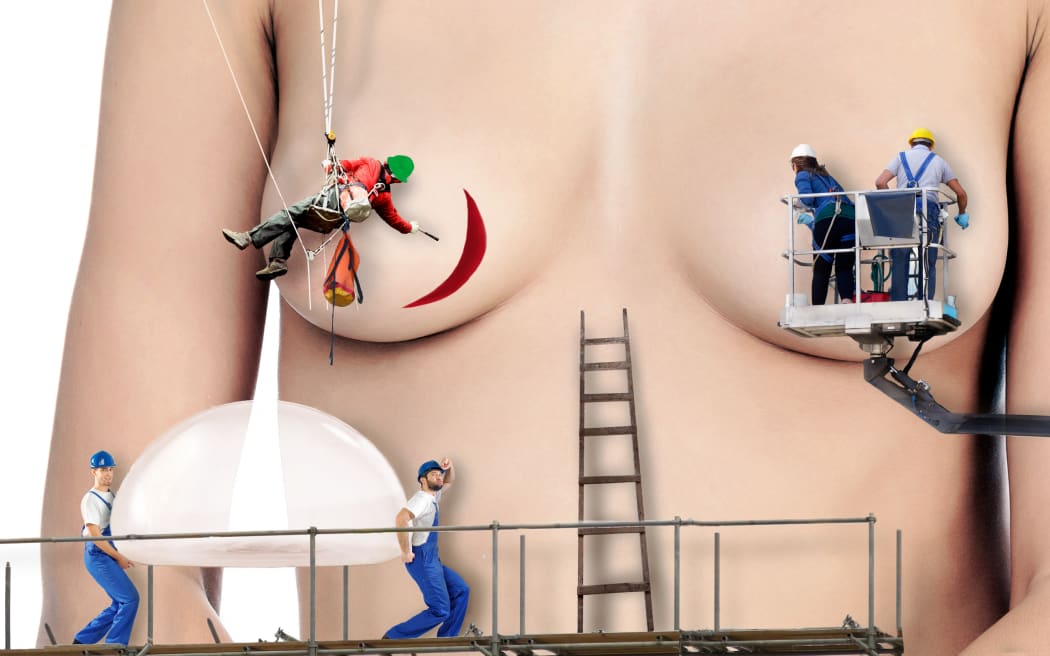As plastic surgery becomes more accepted than ever, we talk to young Kiwis who are opting to nip, tuck and cut.

Photo: Tom Furely
Hannah* ran up the stairs, still drowsy from the drugs that had put her to sleep not long before. When she reached the top, she glanced down at a pool of blood accumulating at her feet.
“Mum!” she screamed. “I think the dog’s bleeding!
It took a few seconds for Hannah to realise the blood was actually coming out of her. A wound on her hip had opened up where surgeons had recently inserted a tube and vacuumed out the fat around her thighs.
“It is actually a really violent procedure and the bruising is horrific,” she says. “My legs looked like swollen bananas. Just yellow and purple bruises everywhere.”
When Hannah was 20, she got liposuction: a type of cosmetic surgery where excess fat is “sucked” out from under the skin using a narrow hose. Now 24, she is one of a growing number of young people worldwide opting to nip, tuck, and cut away their imperfections.
Amidst the plethora of selfies and tell-all YouTube videos, plastic surgery is more acceptable than ever. A staggering 20 million cosmetic procedures were performed throughout the world last year with women making up 85 per cent of patients.
Plastic surgeons in countries like Korea, England, and Canada are reporting rises in the number of younger people seeking cosmetic procedures. In the US, nearly 60 per cent of surveyed plastic surgeons saw an increase in cosmetic surgery and injectables in those under 30.
I remember going to Laneway and feeling like my body was in fundamental opposition to what was considered attractive.
No one knows exactly how much cosmetic surgery is being performed in New Zealand since national statistics are not currently collected. It is generally accepted, however, that there has been a big rise in the past 10 years.
Hannah decided to get liposuction when she was 19 after years of unhappiness with her pear-shaped frame. Her dissatisfaction was at its worse when she left her all-girls high school and moved into a hall of residence where, suddenly, she was faced with boys and the daily stress of what to wear.
“I remember going to Laneway and feeling like my body was in fundamental opposition to what was considered attractive. I just felt like it was objectively wrong.”
After a tough first year at university, Hannah lost nearly 10 kilograms. Even still, she couldn’t shift the weight around her lower half, leaving her feeling out of proportion and frustrated.
“My father, who’s a doctor, said liposuction is something I could consider. At first I was really, really offended but then actually, I thought yeah, that’s a viable option.”
Several months later, Hannah’s surgery was booked. Friends told her she didn’t need it, and a nurse at the hospital even tried to change Hannah’s mind, asking if she was absolutely sure she wanted go ahead with it.
“I think to other people, I had a normal body, not one that was deserving of significant change. But I just felt unattractive.”
Hannah stresses that liposuction isn’t an easy weight loss solution, but is instead for people who have fat deposits in areas they couldn’t otherwise remove through diet and exercise.
“I was exercising most days and eating healthily and I still couldn’t shift the weight.”
The surgery cost $8,000 which Hannah says was a significantly reduced price due to her dad’s connections in the medical community. The surgeons sucked about 3 and ½ litres of fat from her thighs and hips in a two-hour procedure.
“I think there is a real stigma attached to plastic surgery. It’s often regarded as this superficial thing to do, especially liposuction. I was concerned that people might think I was lazy or that it was an easy way out. That wasn’t the case.”
Hannah says it’s important that women have ownership over their bodies, irrespective of the male gaze or media-imposed standards of beauty.
“It just gave me so much more confidence. I mean, I finally feel comfortable in my body.”
“I don’t know if we should endorse things like this actively, but I think it should definitely be something available to women that they aren’t criticized for.”

Photo: Tom Furley
OVERSEAS OPTIONS
Morgan* has never shy about her body. The 24-year-old happily goes topless on the beach and chats about the joys of nipple stimulation.
She doesn’t have the level of dissatisfaction with her body that you might expect from someone considering irreversible surgery, but Morgan is no less determined to get work done.
“My boobs are about a full C-cup. I know that’s not small by any means, but I wish there was a little more of them. I’ve been blessed and cursed with Kim Kardashian-like hips and I want my chest to match.”
Morgan is planning a trip to Thailand to get her breasts enlarged, something she’s wanted since she was a teenager. Breast augmentation would cost Morgan about $14,000 at home, but she’ll only need $5500 to get it done in Bangkok - that’s including flights.
Medical tourism is the term used to describe people travelling overseas for surgery, and it’s booming worldwide. According to Patients Beyond Borders, it’s a NZ$60 billion dollar industry with about 11 million surgery-hopefuls leaving home to go under the knife.
While we don’t yet know the exact number of Kiwis going on medical tourism trips, Stunning Makeovers co-founder and director Paul McGowan says he sends hundreds to Thailand and Malaysia from here each year.
Stunning Makeovers opened in 2008 and is now the biggest New Zealand-based medical tourism company. They organise everything for their clients: flights, accommodation, transfers from airport and hospital, and of course, surgery. Clients can take their pick of from a long list of procedures including breast augmentation, dental work and vision correction.
They also run group trips, and the latest pack of 17 are currently in Bangkok. Amongst them, there’s a 73-year-old getting an armlift and a 24-year-old getting a breast reduction. Paul says surgery through the company is about one third of the cost of having it in New Zealand.
“A breast augmentation, for example, including accommodation in a 4-star hotel, transfers, plus airfare is about $7,000 with us. In New Zealand, you’d probably pay about $12,000 upwards.”
People like him are often seen as the villains by local surgeons who warn off potential clients because of the risks, says Paul, but the reality is that there are always risks with surgery.
“There will be people who are dissatisfied, but it’s the same with New Zealand surgeons.”
“Our clients don’t have the money to be able to get surgery on Remuera Road. It’s a different market. Our ladies tend to be middle class, just average people.”
At the end of the day, it’s my body and it’s my life. If that’s what I want to do, I should be able to without any prejudice.
Morgan already knows the exact surgeon she wants in Thailand as well as the type of implants she’d like. She’s even researched the best types of incisions to limit the risk of losing her nipple sensitivity.
“There is so much competition in Thailand that some of the doctors go study at world-class institutions to really put their names above everyone else,” she says.
“I’ve done a lot of research and I feel like I’m thoroughly educated on it now.”
After her breast surgery, Morgan doesn't think she’ll want any more work done, although she’s already started Botox injections to keep her burgeoning forehead lines at bay.
“You look at people like Sandra Bullock and Jennifer Lopez who are in their forties and there isn’t a goddamn wrinkle on their face. There is a lot of pressure on women to live up to that.”
“At the end of the day, it’s my body and it’s my life. If that’s what I want to do, I should be able to without any prejudice.”
Plastic surgeon Dr Sally Langley has a simple piece advice for anyone thinking about getting surgery overseas: “Don’t do it. It’s a really bad move.”
Langley, who has been working in public and private hospitals for 25 years, says despite what it might say online, you can't be sure of the training of surgeons overseas.
“Invasive surgery under the skin should be done by a plastic and reconstructive surgeon. It shouldn’t be a surgeon who thinks they might like do breasts and liposuction.”
Patients in New Zealand are close to their surgeons for follows-ups in case anything goes wrong, says Langley.
“I’m not saying that we don’t have complications with our own patients. We all certainly do have a few, but we’re well setup to deal with them.”
The price of surgery in New Zealand is made up of three main costs and none of them are cheap: the surgeon’s fee, the anaesthetist’s fee, and the hospital. The costs can be broken down further to things like the registered nurses, the hospital room, medical supplies and medication.
“It's worth paying more and getting safe surgery close to home”, says Langley.
New Zealand is following international trends with a growing number of procedures carried out each year. Plastic surgeons generally find breast augmentation the most popular request.
“People are earning more money than they were previously, so economically, people can afford it. It’s also being promoted a lot and becoming more socially accepted.”
DECIDING TO DOWNSIZE
Not everyone is after a bigger bust, in fact, Langley says numbers of breast reductions are hot on the heels of augmentation.
Jasmine*, 28, spent most of her life struggling with her huge chest. She finally decided to get the weight reduced two years ago.
“I started getting breasts when I was eight. Maybe even seven. It was awkward for my grandma and she actually took me to the doctor and was like ‘what the hell is wrong with her!’”
By the time Jasmine was 12, she was already wearing a C-cup bra and as her breasts grew, so did the challenges
“I had brothers so I used to play a lot of sport and it wasn't easy with my bust. Even my cricket coach once said ‘woah these get in the way, aye?’”
Jasmine, who’s half Malaysian and half Indian, compared herself to her slim, flat-chested friends and grew more frustrated. She hit an F-cup when she was 14, and after having a baby at 18-years-old, Jasmine's breasts ballooned further, pulling on her neck and causing her to have headaches.
“I was sick of not being able to just walk into K-Mart and buy a bra just like every other girl. I was sick of going shopping and not being able to fit anything because of my bust.”

Photo: Tom Furley
At 26, Jasmine decided to apply for a public health grant that would pay for a breast reduction. She remembers desperately asking the surgeon to take her right down to an A-cup, but was told that was not possible.
“They look 1kg off my chest and I still wear a G-cup.”
She was sent home with a drains on each side of her to collect the blood and puss coming out of the wounds. A nurse was assigned to visit her at home and clean the wounds.
The recovery took a long time, and Jasmine had to figure out how to work with her new body: everything from her posture to her balance had changed.
“You don’t think about your balance being a thing, but I was standing to support that weight, and when that weight changes, so do did my centre of gravity.”
Jasmine has been left with scars on both of her breasts. She remembers soon after the surgery, looking in the mirror and thinking “what the hell did I do?”
The tinge of regret was made worse since, around the time she went under the knife, stars like Nicki Minaj, Kim Kardashian and Iggy Azalea were being celebrated for their larger-than life booties, small waists and generous busts.
“If I still had them now, in the mind space I’m in now, I don’t know. I might have put up with them for another 10 years,” says Jasmine.
But Jasmine has noticed benefits: for one, she can now walk around with no bra and it’s a freedom she loves.
“There is no way I could’ve done that before because of the weight. There was always a fear of the skin ripping.
“I mean, I never sit and regret the surgery for more than a minute,” says Jasmine. “I just think people should really think about it because it’s a traumatic experience for the body, it’s really not natural.”
*Names have been changed
For more information about plastic surgery, visit the New Zealand Association of Plastic Surgeons website.

